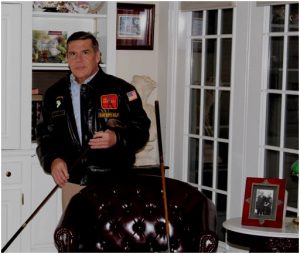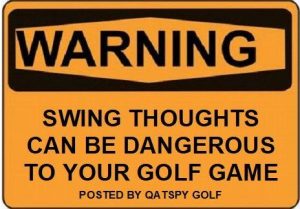Description
Inside-the-leather Classic Golf Swing Mechanics and simple golf swing tips for self-coaching techniques.

By: Charles W. Boatright, Author of The ESPY Golf Swing Coach, Delta Technique Geared for Distance and Control
Subconscious Mind- The Mental Game of Golf, The Five-Inch Course Between the Ears
The QATSPY Golf APP is focused on the mental part of the golfer’s golf game as stated by Bobby Jones, Sr.- “Golf is a game that is played on a five-inch course – the distance between your ears,” or the neuromuscular, the golfer’s muscle memory. Muscle memory is the mental game of golf that is governed by 10- Mental Rules of the Subconscious Mind.
Bobby Jones, Sr. was probably one of the top golfer’s to have placed more emphasis on the mental part of the golfer’s game than he did the physical part of golf. Bobby Jones, Sr. like Yogi Berra, a former New York Yankee, talking about baseball stated- Baseball is 90 percent mental and the other half is physical. This Yogism can equally be applied to the golfer’s game.
During my Xerox Box Golf Project, I gathered more material on the mental portion of the golfer’s game than I gathered on the physical portion. I confirmed this during an interview I had with a Vietnam War P.O.W. in Hattiesburg, MS. Colonel George Robert Hall was held for over seven years at the Hanoi Hilton. Six-weeks after Col. Hall’s release he was invited to play in the PGA Greater New Orleans POW Pro-Am Open where he shot his handicap of four (4) on one of the biggest stages in golf. To read more about Colonel Hall and my interview with him, refer to my article: Col. Hall- P.O.W. Veteran at the Hanoi Hilton

The QATSPY 10-Mental Rules of Golf, the Subconscious Mind:
NOTE: If the golfer experience a slump or difficult finding their golf swing, like in the movie The Legend of Bagger Vance, the golfer needs to pay close attention to Mental Rule of Golf No. 7 and 9. Remember the golfer can’t practice themselves out of a their mental slump, the golfer will have to play their way out of their mental slump.
Practicing your golf swing on the practice range and taking golf lessons are a conscious effort. Playing golf is played with the subconscious mind, that comprise 90 percent of the golfer’s capability on the golf course. This is one reason the golfer finds is difficult to take their golf swing from the practice range or from golf lessons to the golf course.
This one thing that I can guarantee the golfer, you may very well practice your golf swing and take golf lessons using your conscious mind concerning the WHAT, but I can guarantee the golfer that once they step foot onto the golf course that they will be relying totally on their subconscious mind. The subconscious mind runs the show when it comes to HOW on the golf course.
Focusing Instinctive Instead of Thinking about Techniques and Mechanics
All due respects to Bryson DeChambeau in his interview with David Feherty on Golf Channel, Monday, 25Mar2019. But Bryson will develop a significant conflict in his golf game if he doesn’t learn to focus instead of think. Thinking will cause the golfer to have a meltdown. In the interview with David Feherty, Bryson stated that thinking isn’t what confuse him on the golf course, it is instead thinking about the wrong thing that confuses him.

Rules No. 7 and 9 disputes Bryson’s theory on thinking on the golf course. To achieve top performance on the golf course, the golfer’s mechanics and techniques must be instinctive. It is the same issue that effects Major League Baseball pitchers that can develop on the mount. Once they shift their attention from focusing on the strike zone to thinking about their mechanics and techniques they lose their control.
This usually when the manager of the team pays a visit to the mound and signals for the relief pitcher to come into the game. The only problem with this scenario in golf, the golfer doesn’t have a team mate to finish their round for them. If the golfer starts having a meltdown on the golf course there’s no calling for time. Your IT to figure IT out for yourself in real time on the course.
The Caddyshack Quote of Be the Ball
Remember one of the greatest quotes in golf was in the movie Caddyshack by Ty Webb to Danny Noonan- I’m going to give you a little advice. There’s a force in the universe that makes things happen. And all you have to do is get in touch with it, stop thinking, let things happen, and be the ball.
- Get in touch with it– IT is the golfer’s subconscious mind. The golfer’s element and conditions must be familiar, normal, and routine to use it on the golf course. The golf swing must become routine, like the baseball swing is to the batter. I don’t know too many batters that think about their baseball swing in the batter’s box while looking at a 95-mph fastball about 24-inches from their body.
- Stop thinking– A high level of relaxation, confidence, and muscle memory must be present, that doesn’t involve thinking. In the case of an experienced driver, the majority of their tasks are instinctive, which doesn’t require a conscious effort or thinking on their part. These tasks are subconscious elements, as a matter of fact, almost relaxing, compared to that of a new driver who has to think about every element.
- Be the Ball– The conscious and subconscious minds are focused on two different tasks at the same time. The golfer needs to learn how to focus with their conscious mind instead of thinking. Like the baseball pitcher on the mound, once they start thinking they are done.
The 10-Mental Rules of Golf the Subconscious Mind in Golf:
- The subconscious mind does not differentiate between visualizations and real situations: This allows the golfer to use their mental capabilities to develop a Quintessential Athletic Technique (QAT), or the ability to train under mental conditions that the golfer will perform under. The golfer predominately trains with the conscious mind, but the golfer performs with the subconscious mind on the course. The QATSPY process develops an effective training process that the golfer will need to have the mental conditions in place that reflect the mental conditions of the course.
- Your subconscious feels that time passes faster: When the golfer can develop and heighten the sense of subconscious focus, the actual time seems to slow down. A baseball player, like Wade Boggs, in the batter’s box can develop an altered time zone where he can actually slow down the pitch to see the stitching on the baseball. If the baseball player can focus their conscious attention on the pitch, then the subconscious mind is freed up to connect with their muscle memory.
- The longer the subconscious mind believes something, the harder will it will be to alter this belief: A golfer who can develop an ExtraSensory Performance, muscle memory, or neuromuscular motor skills training, the golfer can hard-wire their training into their subconscious mind. The Quintessential Athletic Technique (in the QATSPY) uses three of the athlete’s five senses to develop an involuntary response-type performance (vision, feel, and sound).
- Every thought causes a physical reaction: This is the biggest influence that the golfer’s conscious mind has over the subconscious mind. The subconscious mind can’t distinguish between a negative or a positive thought process. If the golfer’s last thought is not to hit the golf ball into the water hazard, the subconscious mind takes that as a directive. The golfer’s conscious mind needs to focus on what to do, instead of what not to do.
- What the conscious mind expects tends to be subconsciously performed: If the golfer can develop a conscious training and self-coaching procedure similar to the conditions that the golfer will encounter on the course, the golfer’s subconscious mind can develop the self-coaching performance. Nick Faldo stated at the 2015 Quicken Loans Tournament that the golfer has to become their own golf coach out on the course. The key word here is similar conditions. Remember, in golf the range is actually a hitting range, not a practice range. The range does not reflect the conditions on the course. So practice how you play; and play how you practice and become your own golf coach.
- Finding proof to your beliefs strengthens them: The subconscious mind is result-oriented. If the subconscious mind can’t confirm the golfer’s training with real-time results, the subconscious mind will not retain the golfer’s training. The subconscious mind has to have proof that a procedure actually works before it can retain that procedure. This is one reason that the golfer finds it hard to carry their training and/or lessons from practice to the course. The subconscious mind will actually sabotage the golfer’s training if it doesn’t perform these under similar conditions to the course. This is why a scrimmage-type practice is essential for the golfer to train under. A great technique to use for this type of training is the 405- Training Drill.
- The subconscious mind always prevails in conflicts with the conscious mind: This is the single biggest factor affecting the golfer’s performance on the golf course. If the conditions the golfer or athlete trains under don’t resemble the conditions the golfer will perform under, the subconscious mind will rely on its last performance and not on recent practices. If the long hours the golfer trains under don’t resemble conditions the golfer with perform under, the golfer can only expect to retain less than 15 percent of their training or golf lesson(s). This even applies to the professional athletes. If you don’t train to be your own golf coach during practice sessions, then you, as the golfer, can’t meet the performance level you are expecting on the course where it counts.
- A muscle memory, once established, will remain firmly in place until it is replaced by another: Muscle memory is difficult to change, once it has been established, for good or bad. The reason is that the subconscious mind is treating the golfer’s original muscle memory as a survival skill. To change an existing muscle memory, the golfer has to prove over time that the muscle memory is an effective, natural progression and can provide the desired results. If not, the subconscious mind will maintain the original muscle memory.
- The greater the conscious effort, the less the subconscious response will be: This can be best explained by the example of someone who suffers from insomnia. Consciously thinking about trying to sleep will only make it even more difficult to fall asleep. The person who avoids consciously thinking about falling asleep will find it easier to fall asleep. Yogi Berra had a great question- How can you think and hit at the same time? The answer is, you can’t. The more the golfer thinks about their golf swing that should be a natural instinctive, or a muscle memory, the harder the golfer will find it to make the desired golf shot. Thinking about one’s golf swing leads to losing feel for the swing and then comes the slump.
- Suggestions and images can be used to “program” the subconscious mind: What the golfer focuses on, the golfer will perform. In the QATSPY, the Quintessential Athletic Technique, I have three simple elements that I visually set up throughout the day and during my training sessions. This sequence is based on three muscles memory that are instinctive of Sync, Preset, and Yaw in the QATSPY process. Each element is tied directly to a particular ergonomic muscle memory listed below for the right-handed golfer:
You may very well practice your golf swing and take golf lessons using your conscious mind concerning the WHAT, but I can guarantee the golfer that once they step foot onto the golf course, they will be relying on their subconscious mind. The subconscious mind runs the show when it comes to HOW on the golf course. The 405- Training Drill will allow the golfer to bridge the gap in the golf game.
I produced a YouTube Video that not only demonstrated the Sync/Preset Maneuver, but also demonstrated how to use the subconscious mind to use in your routine training sessions. I used a throw-down Home Plate to demonstrate the 12-Foot Bunt-Type Chip/Pitch shot that is one of the hardest shots in golf to make. If you can perform this shot with camera running and under the lights, you can perform this on the golf course.
This Self-Coaching download contains 17 pages of simple step-by-step procedures, tips, and illustrations to help the golfer apply and retain the material presented on and off the golf course.
To develop your ESP Self-Coaching Technique Forum in Your Golf Game, please select to download your E-Copy of this Online Golf Self-Coaching Training Procedure (STP). The advantage of the online Golf STP is it a training procedure that you will have in your electronic files for future reference and NOT a one-time lesson where the presented material will be forgotten later or once on the golf course.




